春节习俗英文版学习
- 格式:ppt
- 大小:3.39 MB
- 文档页数:17
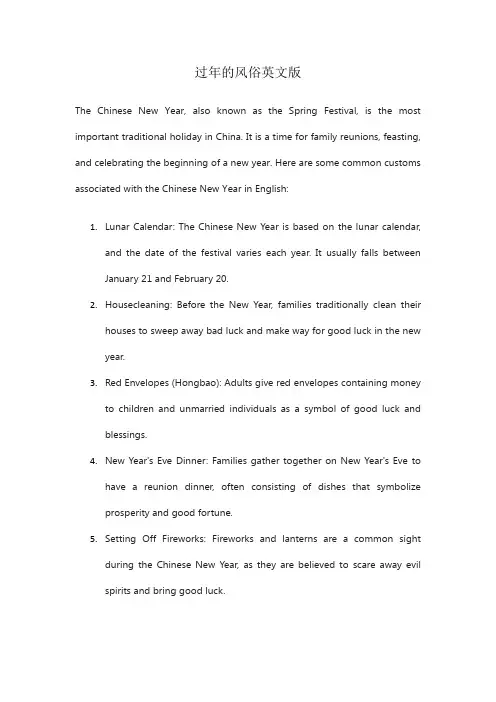
过年的风俗英文版The Chinese New Year, also known as the Spring Festival, is the most important traditional holiday in China. It is a time for family reunions, feasting, and celebrating the beginning of a new year. Here are some common customs associated with the Chinese New Year in English:1.Lunar Calendar: The Chinese New Year is based on the lunar calendar,and the date of the festival varies each year. It usually falls between January 21 and February 20.2.Housecleaning: Before the New Year, families traditionally clean theirhouses to sweep away bad luck and make way for good luck in the new year.3.Red Envelopes (Hongbao): Adults give red envelopes containing moneyto children and unmarried individuals as a symbol of good luck and blessings.4.New Year's Eve Dinner: Families gather together on New Year's Eve tohave a reunion dinner, often consisting of dishes that symbolize prosperity and good fortune.5.Setting Off Fireworks: Fireworks and lanterns are a common sightduring the Chinese New Year, as they are believed to scare away evil spirits and bring good luck.6.Lion and Dragon Dances: Performances of lion and dragon dances are apopular way to celebrate the New Year, as they symbolize good luck and prosperity.7.Visiting Relatives and Friends: During the Chinese New Year, people visittheir relatives and friends, exchange greetings, and offer gifts such as oranges, which symbolize good luck.8.Temple Fairs: Many cities and towns hold temple fairs during theChinese New Year, where people can buy gifts, enjoy performances, and pray for good luck in the new year.These are just some of the many customs associated with the Chinese New Year. The festival is a time for joy, celebration, and reflection on the past year while looking forward to the future.。
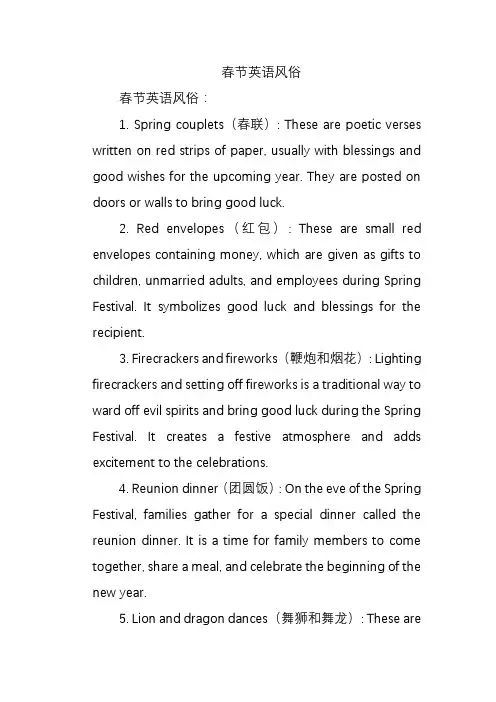
春节英语风俗春节英语风俗:1. Spring couplets(春联): These are poetic verses written on red strips of paper, usually with blessings and good wishes for the upcoming year. They are posted on doors or walls to bring good luck.2. Red envelopes(红包): These are small red envelopes containing money, which are given as gifts to children, unmarried adults, and employees during Spring Festival. It symbolizes good luck and blessings for the recipient.3. Firecrackers and fireworks(鞭炮和烟花): Lighting firecrackers and setting off fireworks is a traditional way to ward off evil spirits and bring good luck during the Spring Festival. It creates a festive atmosphere and adds excitement to the celebrations.4. Reunion dinner(团圆饭): On the eve of the Spring Festival, families gather for a special dinner called the reunion dinner. It is a time for family members to come together, share a meal, and celebrate the beginning of the new year.5. Lion and dragon dances(舞狮和舞龙): These aretraditional performances where dancers dress up as lions or dragons and perform lively dances accompanied by drumming and music. It is believed to bring good luck and drive away evil spirits.6. Temple fairs(庙会): During the Spring Festival, temporary fairs are set up around temples where people can enjoy various activities such as shopping, eating traditional snacks, watching performances, and playing games.。

春节的习俗英文版Chinese New Year, also known as the Spring Festival, is the most important traditional holiday in China. It is a time for family reunions, honoring ancestors, and welcoming the arrival of spring. Here are some customs and traditions associated with this festive occasion:1. Cleaning and Decorating: Prior to Chinese New Year, families thoroughly clean their houses to remove all the bad luck of the past year and make way for good luck to come. Red lanterns, paper cuttings, and couplets with auspicious phrases are put up to bring good fortune.2. Reunion Dinner: The reunion dinner, also known as "Nian Ye Fan," is a significant part of the Chinese New Year celebration. Families gather to enjoy a lavish feast, which usually includes various traditional dishes symbolizing good luck and prosperity.3. Red Packets: During Chinese New Year, adults give red packets, known as "Hongbao," to children and unmarried young adults to share blessings and good wishes. The red color is considered lucky and is believed to ward off evil spirits.4. Firecrackers and Lion Dance: Firecrackers are set off at midnight on Chinese New Year's Eve to scare away evil spirits. Lion dances are performed in the streets with colorful lions and loud drums to bring prosperity, good luck, and happiness.5. Lantern Festival: The 15th day of the Chinese New Year marks the Lantern Festival, when people light lanterns and release theminto the sky. It symbolizes the end of the New Year celebrations and the beginning of a new life.6. Dragon Dance: The dragon dance is a traditional performance during Chinese New Year, often seen in parades. It involves a team of performers holding up a long dragon-shaped costume and performing intricate movements to bring good luck and fortune.7. Sticky Rice Cake: The sticky rice cake, also known as "Nian Gao," is a traditional Chinese New Year food. It is made from glutinous rice and is believed to bring prosperity and progress in the coming year.8. Visiting Relatives and Friends: Chinese people visit their relatives and friends during the festival to exchange greetings and well-wishes. This is an opportunity to strengthen family bonds and maintain social connections.9. Temple Fairs: Temple fairs are held during Chinese New Year in many cities, offering various traditional cultural activities such as folk performances, traditional snacks, and handicrafts. It is a lively and festive atmosphere that attracts both locals and tourists.10. Lantern Riddle Guessing: Lantern riddle guessing is a popular game played during the Lantern Festival. Riddles are written on lanterns, and people have to guess the answers. It is a playful way to enhance intelligence and enjoy the festive spirit.These customs and traditions bring joy, luck, and blessings to millions of people celebrating the Chinese New Year. It is a timewhen families come together, honoring traditions and embracing new beginnings as they welcome the arrival of spring.。
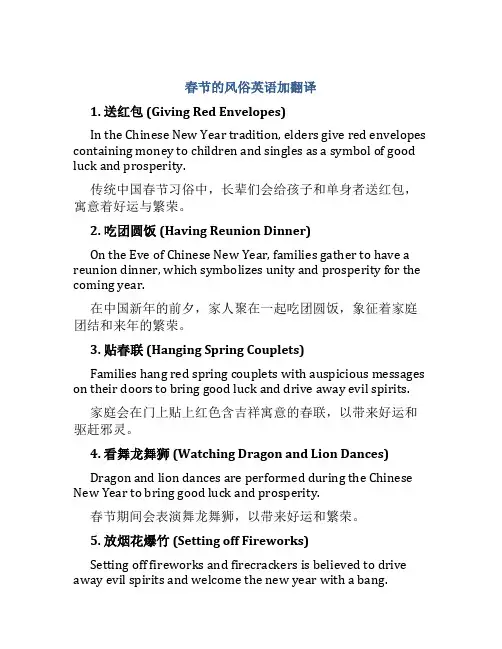
春节的风俗英语加翻译1. 送红包 (Giving Red Envelopes)In the Chinese New Year tradition, elders give red envelopes containing money to children and singles as a symbol of good luck and prosperity.传统中国春节习俗中,长辈们会给孩子和单身者送红包,寓意着好运与繁荣。
2. 吃团圆饭 (Having Reunion Dinner)On the Eve of Chinese New Year, families gather to have a reunion dinner, which symbolizes unity and prosperity for the coming year.在中国新年的前夕,家人聚在一起吃团圆饭,象征着家庭团结和来年的繁荣。
3. 贴春联 (Hanging Spring Couplets)Families hang red spring couplets with auspicious messages on their doors to bring good luck and drive away evil spirits.家庭会在门上贴上红色含吉祥寓意的春联,以带来好运和驱赶邪灵。
4. 看舞龙舞狮 (Watching Dragon and Lion Dances)Dragon and lion dances are performed during the Chinese New Year to bring good luck and prosperity.春节期间会表演舞龙舞狮,以带来好运和繁荣。
5. 放烟花爆竹 (Setting off Fireworks)Setting off fireworks and firecrackers is believed to drive away evil spirits and welcome the new year with a bang.放烟花爆竹被认为可以驱散邪灵,热闹迎接新的一年。

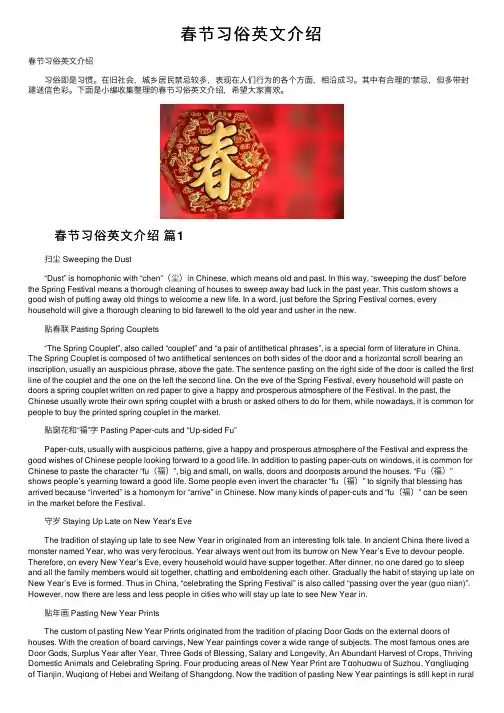
春节习俗英⽂介绍春节习俗英⽂介绍 习俗即是习惯。
在旧社会,城乡居民禁忌较多,表现在⼈们⾏为的各个⽅⾯,相沿成习。
其中有合理的'禁忌,但多带封建迷信⾊彩。
下⾯是⼩编收集整理的春节习俗英⽂介绍,希望⼤家喜欢。
春节习俗英⽂介绍篇1 扫尘 Sweeping the Dust “Dust” is homophonic with “chen”(尘)in Chinese, which means old and past. In this way, “sweeping the dust” before the Spring Festival means a thorough cleaning of houses to sweep away bad luck in the past year. This custom shows a good wish of putting away old things to welcome a new life. In a word, just before the Spring Festival comes, every household will give a thorough cleaning to bid farewell to the old year and usher in the new. 贴春联 Pasting Spring Couplets “The Spring Couplet”, also called “couplet” and “a pair of antithetical phrases”, is a special form of literature in China. The Spring Couplet is composed of two antithetical sentences on both sides of the door and a horizontal scroll bearing an inscription, usually an auspicious phrase, above the gate. The sentence pasting on the right side of the door is called the first line of the couplet and the one on the left the second line. On the eve of the Spring Festival, every household will paste on doors a spring couplet written on red paper to give a happy and prosperous atmosphere of the Festival. In the past, the Chinese usually wrote their own spring couplet with a brush or asked others to do for them, while nowadays, it is common for people to buy the printed spring couplet in the market. 贴窗花和“福”字 Pasting Paper-cuts and “Up-sided Fu” Paper-cuts, usually with auspicious patterns, give a happy and prosperous atmosphere of the Festival and express the good wishes of Chinese people looking forward to a good life. In addition to pasting paper-cuts on windows, it is common for Chinese to paste the character “fu(福)”, big and small, on walls, doors and doorposts around the houses. “Fu(福)”shows people’s yearning toward a good life. Some people even invert the character “fu(福)” to signify that blessing has arrived because “inverted” is a homonym for “arrive” in Chinese. Now many kinds of paper-cuts and “fu(福)” can be seen in the market before the Festival. 守岁 Staying Up Late on New Year's Eve The tradition of staying up late to see New Year in originated from an interesting folk tale. In ancient China there lived a monster named Year, who was very ferocious. Year always went out from its burrow on New Year’s Eve to devour people. Therefore, on every New Year’s Eve, every household would have supper together. After dinner, no one dared go to sleep and all the family members would sit together, chatting and emboldening each other. Gradually the habit of staying up late on New Year’s Eve is formed. Thus in China, “celebrating the Spring Festival” is also called “passing over the year (guo nian)”. However, now there are less and less people in cities who will stay up late to see New Year in. 贴年画 Pasting New Year Prints The custom of pasting New Year Prints originated from the tradition of placing Door Gods on the external doors of houses. With the creation of board carvings, New Year paintings cover a wide range of subjects. The most famous ones are Door Gods, Surplus Year after Year, Three Gods of Blessing, Salary and Longevity, An Abundant Harvest of Crops, Thriving Domestic Animals and Celebrating Spring. Four producing areas of New Year Print are Tɑohuɑwu of Suzhou, Yɑngliuqing of Tianjin, Wuqiɑng of Hebei and Weifang of Shangdong. Now the tradition of pasting New Year paintings is still kept in ruralChina, while it is seldom followed in cities. 吃饺⼦ Having Jiaozi On New Year’s Eve, the whole family will sit together to make jiaozi and celebrate the Spring Festival. The shape of jiaozi is like gold ingot from ancient China. So people eat them and wish for money and treasure. The tradition of having jiaozi is very important during the Spring Festival. You cannot have a complete Spring Festival without having jiaozi. (See page 82 for more information about “jiaozi”) 看春节联欢晚会 The CCTV New Year's Gala The New Year’s Gala is a variety show held by China Central Television (CCTV) since 1983. For every year since then at the turn of the Lunar New Year, the program begins at 8:00PM and lasts five or six hours. It brings laughter to billions of people, creates many popular words and produces lots of TV phenomena meriting attention. For over twenty years, its value has gone far beyond a variety show. It is essential entertainment for the Chinese both at home and abroad. Many Chinese would like to watch the gala while having the dinner on New Year’s Eve. 放鞭炮 Setting off Firecrackers The firecracker is a unique product in China. In ancient China, the sound of burning bamboo tubes was used to scare away wild animals and evil spirits. With the invention of the gunpowder, “firecracker” is also called “鞭炮biānpào” (“炮” in Chinese means gun) and used to foster a joyful atmosphere. The first thing every Chinese household does is to set off firecrackers and fireworks, which are meant to bid farewell to the old year and usher in the new. In the past few years, such an activity was completely or partially forbidden in big cities including Beijing due to fire and personal casualty caused by burning firecrackers. However, some Chinese thought that a Spring Festival without firecrackers was not lively enough and they burned firecrackers by stealth. So in recent years, the ban was canceled again. This shows that burning firecrackers is a very important activity during the Spring Festival. 拜年和压岁钱 New Year's Visit and Gift Money On the first day of the Chinese lunar year, everybody puts on their best clothes and pays ceremonial calls on their relatives and friends, wishing them all the luck in the coming year. Juniors will greet seniors, wishing them health and longevity, while seniors will give juniors some gift money as a wish for their safety in the coming year. When friends meet, they will wish each other happiness and prosperity with a big smile. With the development of the new technology, there is a change on the way of giving New Years greetings. In recent year, it is common to send New Years greetings by such modern means of communication as telephones, emails and text messages. 逛庙会 Temple Fair Temple fair, usually held outside temples, is a kind of folk custom in China. During the Spring Festival, temple fair is one of the most important activities, in which there are such performances as acrobatics and Wushu, numerous kinds of local snacks and many kinds of things for everyday life. In recent years, the temple fair has become a place for people to appreciate the traditional art and experience the traditional life. 春节习俗英⽂介绍篇2 春节正⽉习俗的英⽂介绍 The Chinese New Year celebrations are marked by visits to kin, relatives and friends, a practice known as "new-year visits" (Chinese: 拜年; pinyin: bài nián). New clothes are usually worn to signify a new year. The colour red is liberally used in all decorations. Red packets are given to juniors and children by the married and elders. See Symbolism below for more explanation. Preceding days 春节前 This article does not cite any references or sources. Please help improve this article by adding citations to reliable sources. Unsourced material may be challenged and removed. (January 2010) On the days before the New Year celebration Chinese families give their home a thorough cleaning. There is a Cantonese saying "Wash away the dirt on ninyabaat" (年廿⼋,洗邋遢), but the practice is not usually restricted onnin'ya'baat (年廿⼋, the 28th day of month 12). It is believed the cleaning sweeps away the bad luck of the preceding year and makes their homes ready for good luck. Brooms and dust pans are put away on the first day so that luck cannot be swept away. Some people give their homes, doors and window-frames a new coat of red paint. Homes are often decorated withpaper cutouts of Chinese auspicious phrases and couplets. Purchasing new clothing, shoes, and receiving a hair-cut also symbolize a fresh start. In many households where Buddhism or Taoism is prevalent, home altars and statues are cleaned thoroughly, and altars that were adorned with decorations from the previous year are also taken down and burned a week before the new year starts, and replaced with new decorations. Taoists (and Buddhists to a lesser extent) will also "send gods" (送神), an example would be burning a paper effigy of Zao Jun the Kitchen God, the recorder of family functions. This is done so that the Kitchen God can report to the Jade Emperor of the family household's transgressions and good deeds. Families often offer sweet foods (such as candy) in order to "bribe" the deities into reporting good things about the family. The biggest event of any Chinese New Year's Eve is the dinner every family will have. A dish consisting of fish will appear on the tables of Chinese families. It is for display for the New Year's Eve dinner. This meal is comparable to Christmas dinner in the West. In northern China, it is customary to make dumplings (jiaozi 饺⼦) after dinner and have it around midnight. Dumplings symbolize wealth because their shape is like a Chinese tael. By contrast, in the South, it is customary to make a new year cake (Niangao, 年糕) after dinner and send pieces of it as gifts to relatives and friends in the coming days of the new year. Niangao literally means increasingly prosperous year in year out. After the dinner, some families go to local temples, hours before the new year begins to pray for a prosperous new year by lighting the first incense of the year; however in modern practice, many households hold parties and even hold a countdown to the new lunar year. Beginning in the 1980s, the CCTV New Year's Gala was broadcast four hours before the start of the New Year. First day 初⼀ The first day is for the welcoming of the deities of the heavens and earth, officially beginning at midnight. Many people, especially Buddhists, abstain from meat consumption on the first day because it is believed that this will ensure longevity for them. Some consider lighting fires and using knives to be bad luck on New Year's Day, so all food to be consumed is cooked the day before. For Buddhists, the first day is also the birthday of Maitreya Bodhisattva (better known as the more familiar Budai Luohan), the Buddha-to-be. People also abstain from killing animals. Most importantly, the first day of Chinese New Year is a time when families visit the oldest and most senior members of their extended family, usually their parents, grandparents or great-grandparents. Some families may invite a lion dance troupe as a symbolic ritual to usher in the Lunar New Year as well as to evict bad spirits from the premises. Members of the family who are married also give red packets containing cash to junior members of the family, mostly children and teenagers. While fireworks and firecrackers are traditionally very popular, some regions have banned them due to concerns over fire hazards, which have resulted in increased number of fires around New Years and challenged municipal fire departments' work capacity. For this reason, various city governments (e.g., Hong Kong, and Beijing, for a number of years) issued bans over fireworks and firecrackers in certain premises of the city. As a substitute, large-scale fireworks have been launched by governments in cities like Hong Kong to offer citizens the experience. Second day 初⼆ The second day of the Chinese New Year is for married daughters to visit their birth parents. Traditionally, daughters who have been married may not have the opportunity to visit their birth families frequently. On the second day, the Chinese pray to their ancestors as well as to all the gods. They are extra kind to dogs and feed them well as it is believed that the second day is the birthday of all dogs. Business people of the Cantonese dialect group will hold a 'Hoi/jr/Nin' prayer to start their business on the 2nd day of Chinese New Year. The prayer is done to pray that they will be blessed with good luck and prosperity in their business for the year. Third and fourth days 初三 The third and fourth day of the Chinese New Year are generally accepted as inappropriate days to visit relatives and friends due to the following schools of thought. People may subscribe to one or both thoughts. 1) It is known as "chì kǒu" (⾚⼝), meaning that it is easy to get into arguments. It is suggested that the cause could be the fried food and visiting during the first two days of the New Year celebration.[citation needed] 2) Families who had an immediate kin deceased in the past 3 years will not go house-visiting as a form of respect to the dead, but people may visit them on this day. Some people then conclude that it is inauspicious to do any house visiting at all. The third day of the New Year is allocated to grave-vi s i t i n g i n s t e a d . / p >。
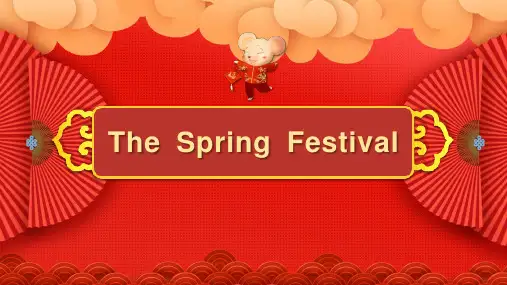
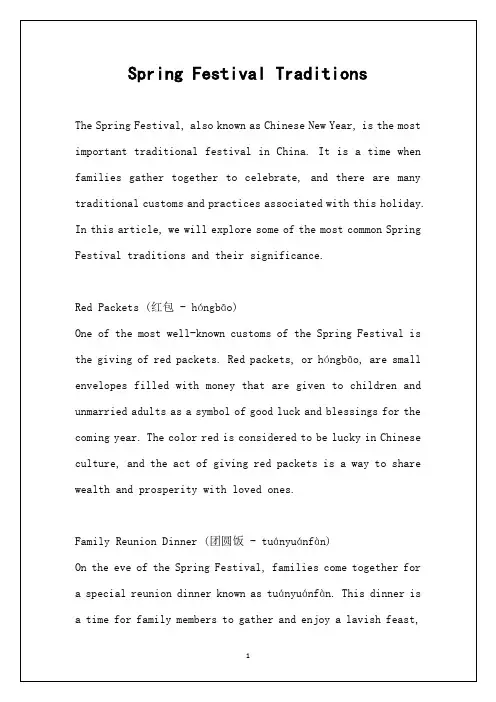
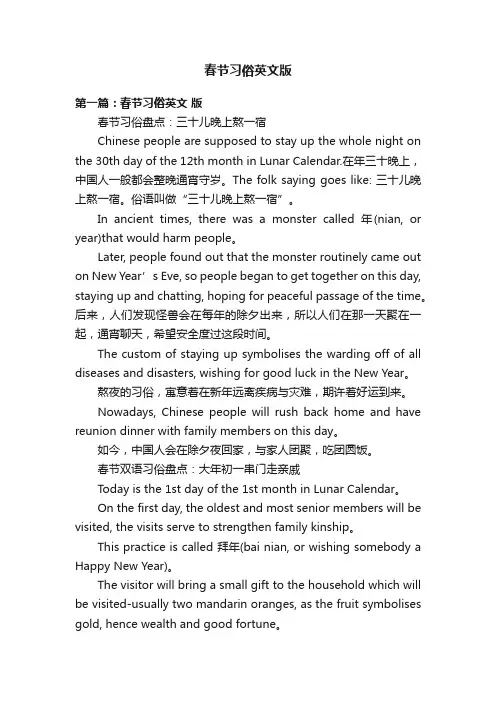
春节习俗英文版第一篇:春节习俗英文版春节习俗盘点:三十儿晚上熬一宿Chinese people are supposed to stay up the whole night on the 30th day of the 12th month in Lunar Calendar.在年三十晚上,中国人一般都会整晚通宵守岁。
The folk saying goes like: 三十儿晚上熬一宿。
俗语叫做“三十儿晚上熬一宿”。
In ancient times, there was a monster called 年(nian, or year)that would harm people。
Later, people found out that the monster routinely came out on New Year’s Eve, so people began to get together on this day, staying up and chatting, hoping for peaceful passage of the time。
后来,人们发现怪兽会在每年的除夕出来,所以人们在那一天聚在一起,通宵聊天,希望安全度过这段时间。
The custom of staying up symbolises the warding off of all diseases and disasters, wishing for good luck in the New Year。
熬夜的习俗,寓意着在新年远离疾病与灾难,期许着好运到来。
Nowadays, Chinese people will rush back home and have reunion dinner with family members on this day。
如今,中国人会在除夕夜回家,与家人团聚,吃团圆饭。
春节双语习俗盘点:大年初一串门走亲戚Today is the 1st day of the 1st month in Lunar Calendar。
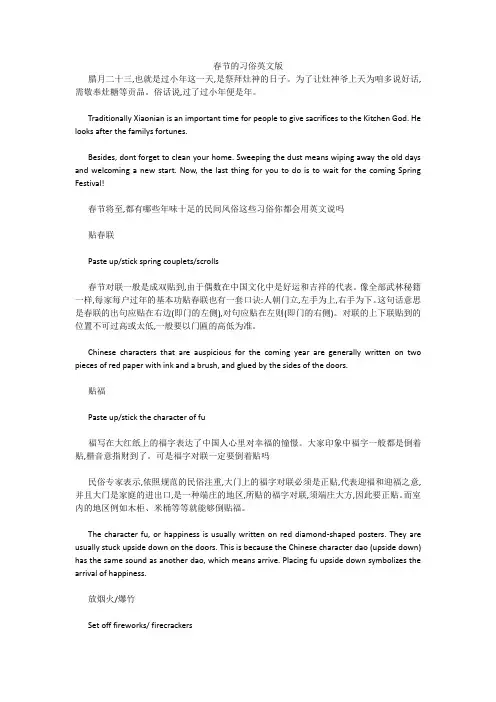
春节的习俗英文版腊月二十三,也就是过小年这一天,是祭拜灶神的日子。
为了让灶神爷上天为咱多说好话,需敬奉灶糖等贡品。
俗话说,过了过小年便是年。
Traditionally Xiaonian is an important time for people to give sacrifices to the Kitchen God. He looks after the familys fortunes.Besides, dont forget to clean your home. Sweeping the dust means wiping away the old days and welcoming a new start. Now, the last thing for you to do is to wait for the coming Spring Festival!春节将至,都有哪些年味十足的民间风俗这些习俗你都会用英文说吗贴春联Paste up/stick spring couplets/scrolls春节对联一般是成双贴到,由于偶数在中国文化中是好运和吉祥的代表。
像全部武林秘籍一样,每家每户过年的基本功贴春联也有一套口诀:人朝门立,左手为上,右手为下。
这句话意思是春联的出句应贴在右边(即门的左侧),对句应贴在左则(即门的右侧)。
对联的上下联贴到的位置不可过高或太低,一般要以门匾的高低为准。
Chinese characters that are auspicious for the coming year are generally written on two pieces of red paper with ink and a brush, and glued by the sides of the doors.贴福Paste up/stick the character of fu福写在大红纸上的福字表达了中国人心里对幸福的憧憬。

春节习俗英文版Chinese New Year, also known as Spring Festival, is the most important holiday in China. It marks the beginning of a new lunar year and is celebrated by over one billion people around the world. Chinese New Year traditions are rooted in ancient customs and are still widely practiced today. Below are some of the most common customs and traditions associated with this holiday.1. Reunion DinnerOn New Year's Eve, families come together for a reunion dinner. This is the most important meal of the year, and every effort is made to ensure that everyone can attend. The meal typically consists of dishes that have symbolic meaning, such as fish (for prosperity), dumplings (for wealth), and longevity noodles (for a long life).2. Red DecorationsRed is the color of luck and fortune in China, and it is the predominant color of Chinese New Year decorations. Red lanterns, banners, and posters with auspicious sayings are hung throughout homes and businesses to bring good luck and ward off evil spirits.3. Red EnvelopesRed envelopes filled with money are given out during Chinese New Year. These envelopes, known as hongbao, are given to children and unmarried adults by their parents and married relatives. The money inside the envelopeis meant to bring good luck and prosperity, and the act of giving hongbao is a way to show love and respect.4. Spring CleaningBefore Chinese New Year, homes are thoroughly cleaned to rid them of bad luck from the previous year. The idea is to sweep away any negative energy to make room for fresh and positive energy in the new year.5. FireworksFireworks are an integral part of Chinese New Year celebrations. They are set off at midnight on New Year's Eve to frighten away evil spirits and bring good luck. In recent years, many cities in China have banned fireworks due to safety and environmental concerns.6. Lion and Dragon DancesLion and dragon dances are performed during Chinese New Year to bring good luck and fortune. These dances are usually performed by trained dancers wearing elaborate lion and dragon costumes. Traditional lion and dragon dances can be seen at temples, community centers, and public events.7. New Year's DayThe first day of the lunar new year is a time for visiting friends and family. It is also a time to honor ancestors and pay respects to the gods. Manypeople will visit temples and offer prayers for good fortune and success in the new year.8. DumplingsDumplings are a traditional food eaten during Chinese New Year. The crescent-shaped dumplings resemble ancient Chinese silver or gold ingots, which were used as currency. Eating dumplings is said to bring wealth and good fortune.9. FishFish is a popular dish during Chinese New Year because the Chinese word for fish (yu) sounds like the word for abundance or surplus. Eating fish is said to bring prosperity and good luck.10. Kumquat TreesKumquat trees are often given as gifts during Chinese New Year. The kumquat fruit is small and round, and its bright orange color represents gold. Giving a kumquat tree is said to bring good luck and wealth.In conclusion, Chinese New Year is a time for family, friends, and tradition. It is a celebration of the past, present, and future, and a time to honor ancestors and welcome prosperity and good fortune. The customs and traditions associated with Chinese New Year reflect the rich cultural heritage of China and are cherished by people all over the world.。
春节是中国及⼀些亚洲民族⼀个古⽼的传统节⽇。
因为相传年兽怕红⾊,怕⽕光和怕响声,所以⼈们便有贴春联、放鞭炮、敲锣打⿎等习俗。
不同时期、不同地区、不同民族的习俗都不相同。
Spring Festival is a traditional festival in China and some Asian nations. Because legend has it that the beast is afraid of red, afraid of fire and afraid of sound, so people will have couplets, firecrackers, gongs and drums and other customs. Different periods, different regions, different ethnic customs are not the same. 在中国,春节也是少数民族⼈民的风俗节⽇。
各族⼈民按照⾃已的习俗,举⾏各种各样的庆祝活动,具有各⾃浓厚的民族独特风采。
春节是中国⼀个古⽼的节⽇,也是全年最重要的⼀个节⽇,如何过庆贺这个节⽇,在千百年的历史发展中,形成了⼀些较为固定的风俗习惯,有许多还相传⾄今。
In China, the Spring Festival is also a minority national people's customs and festivals. People of all ethnic groups in accordance with their own customs, held a variety of celebration, with their strong national unique style. Spring Festival is an ancient festival in China. It is also one of the most important festival in the whole year. How to celebrate this festival, in the history of thousands of years, has formed some relatively fixed customs, there are still many people who have been handed down. 少数民族 Ethnic minority 在中国,春节也是少数民族⼈民的风俗节⽇。
春节习俗从农历正月初一开始的节庆活动可谓丰富多彩,多种多样。
A series of colorful celebration activities begin on the first day of the first lunar month.春节过了以后,就是在过去中国的农村里边,文艺的活动逐渐地展开了,有各种的文艺节目,像我们现在看到的北京花会一样,高跷、旱船,另外就是唱戏。
After the Spring Festival, all kinds of entertainment programs used to be given in the rural areas in China. Just like the flower exhibition in Beijing now, the entertainment programs include walking on stilt s, taking a boat on ground and operas.不管是城里人,还是在农村,人们都要做的一件事就是拜年。
民间流行的拜年活动先是从家里开始的。
No matter in the city or in the countryside, all the people will do one thing that is to extend Spring Festival greetings. This activity begins at first between family members.一般是我们晚辈要给长辈拜年,比如给父母和父母的兄弟姐妹,大爷、大妈等拜年。
Normally we will extend our Spring Festival greetings toour elders, such as our parents, uncles and aunts.亲戚之间在春节期间走动,有互拜平安的意思。
春节的习俗英文版春节的习俗英文版篇一:春节,也被称为农历新年。
对于中国人来说,这是规模最大,最重要的传统节日。
就如同西方的圣诞节一样,春节是一家团聚的日子。
The Spring Festival is also called Chinese Lunar New Year. Being one of the traditional Chinese festivals, it is the grandest and most important festival for Chinese people. It is also the time for whole families to get together, which is similar to Christmas for Westerners.春节从农历新年第一天开始,几乎要持续半个月。
但在民间传统中,这一节日从腊月23日就开始了,一直到正月十五(元宵节)。
It comes on the first day of Chinese lunar calendar and lasts for almost half of a month. But in folk custom, this traditional holiday lasts from the 23rd day of the twelfth month to the 15th day of the first month (The Lantern Festival) on the lunar calendar.大年三十(除夕夜):团圆饭就除夕夜而言,无论身在何处,也不管路途多么遥远,人们都会设法赶回家,所以除夕夜的盛大晚餐也叫做“团圆饭”。
每个家庭的团圆饭都是一年中精心准备的最华丽和隆重的家宴。
女主人在餐桌上摆满精心准备的食物,全家人围坐一起分享美味佳肴,然后一起乐融融地包饺子。
午夜12点,每个家庭都会放鞭炮,辞旧迎新。
春节的传统文化和风俗英文带中文注释春节的传统文化和风俗英文带中文注释:Spring FestivalSpring Festival, also known as Chinese New Year, is one of the most significant traditional festivals in China, embodying rich cultural traditions and unique customs.1. Spring Festival Eve Dinner (Nianye Fan)On the eve of Spring Festival, families gather together to have a reunion dinner, known as Nianye Fan. This meal is considered auspicious and symbolic, often including dishes such as fish (representing abundance and prosperity) and spring rolls (symbolizing wealth and good luck).中文注释:春节前夕,家人会聚在一起吃团圆饭,即年夜饭。
这顿饭寓意吉祥,常包括鱼(代表富足和繁荣)和春卷(象征财富和好运)等菜肴。
2. Giving Red Envelopes (Hongbao)During the Spring Festival, elders often give red envelopes, known as Hongbao, to children and unmarried young adults as a symbol of good luck and a blessing for the new year.These envelopes usually contain money, which is believed to bring prosperity and happiness.中文注释:春节期间,长辈通常会给孩子和未婚的年轻人发红包,作为好运和新年祝福的象征。
春节的风俗英语加翻译During the Spring Festival, there are several customs that are widely observed in China.1. 春联(chūn lián) - Spring coupletsSpring couplets are red banners with poetic verses written on them. They are hung on doorways to bring blessings and good luck for the coming year.2. 团圆饭 (tuán yuán fàn) - Reunion dinnerThe reunion dinner is the most important meal during the Spring Festival. Family members gather together to enjoy a feast and celebrate the beginning of the new year.3. 红包(hóng bāo) - Red envelopesRed envelopes filled with money are given as gifts during the Spring Festival. It is a symbol of good luck and blessings for the recipients.4. 烟花爆竹(yān huā bào zhú) - Fireworks and firecrackers Fireworks and firecrackers are lit during the Spring Festival to drive away evil spirits. It is believed that the loud noises can scare away any bad luck and bring prosperity for the new year.5. 拜年 (bài nián) - Say New Year greetingsDuring the Spring Festival, it is customary to visit friends and relatives to exchange New Year greetings and good wishes for the year ahead.6. 舞龙舞狮(wǔ lóng wǔ shī) - Dragon and lion danceDragon and lion dances are performed during the Spring Festival to bring good fortune and drive away evil spirits. Colorful dragon and lion costumes are worn by performers, who dance to the beat of drums and cymbals.7. 春节联欢晚会(chūn jié lián huān wǎn huì) - Spring Festival GalaThe Spring Festival Gala is a variety show broadcasted on TV annually during the Spring Festival. It features music, dance, comedy, and other performances to entertain people and celebrate the new year.8. 开门红(kāi mén hóng) - Open houseSome people hold open houses during the Spring Festival, where friends and relatives can drop by to visit and share New Year greetings. It is a way to strengthen social connections and maintain relationships.以上是中国春节时常见的风俗习俗。